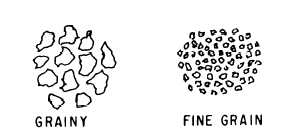difference is great, the negative is said to be contrasty.
When the density difference is small, the negative is said
to be flat or lacking in contrast.
For a negative to have normal contrast, the density
differences between the highlight and shadow areas of
the negative must be proportional to the reflective
brightness range of the subject photographed
A contrasty negative usually is the result of
overdevelopment but also may be caused by a high
scene lighting ratio (a contrasty original scene). A flat
negative, on the other hand, may be caused, primarily,
by underdevelopment or a low-contrast original scene.
TONAL GRADATION
Photographers often concentrate on the density and
detail of highlights and shadows when they should
actually be considering the most important or middle
tones of the negative. Middle tones are the various tones
of gray between the highlights and the shadows; that is,
the densities that are not highlights or shadows are
termed middle tones or intermediate tones. The middle
tones vary with the type of film and the subject contrast.
A negative should have a range of middle tone densities
that correspond proportionally to the middle reflective
brightness of the subject. A panchromatic negative that
does not have proportionate midtones is contrasty or
flat.
GRAININESS
Because photographic images made from film are
made up of fine silver grains, the images may appear
“grainy” or exhibit graininess (fig. 10-22).
All negatives show graininess to some extent. The
most important factors affecting negative graininess are
as follows:
The composition of the emulsion or the inherent
graininess of the emulsion. That is to say, the size of the
grains used to produce the emulsion.
The type of developer used. When fine grain is
desired, a fine-grain developer with the appropriate film
should be used.
The extent of development. Overdevelopment is
a major cause of excessive graininess.
Exposure or negative density. Overexposure is
another key contributor to graininess. As negative
density increases, so does graininess.
Figure 10-22.–Grain structures in emulsions.
Image sharpness. The sharper the film image, the
greater the image detail and the less apparent the
graininess.
EFFECTS OF EXPOSURE AND
DEVELOPMENT VARIATIONS
The nine negatives reproduced in figure 10-23
compare the effects of exposure and development
variations. From the left, they show the effects of
development; from the top, they show the effects of
exposure. The center negative has been given both
correct exposure and normal development and is a
“normal” negative that will print without a filter or with
a No. 2 filter.
Negatives 1, 4, and 7 have been underdeveloped,
while 3, 6 and 9 have been overdeveloped.
The negatives across the top-1, 2, and 3-are
underexposed and lack detail in the shadow areas.
Increasing development (No. 3) had no appreciable
effect on the lack of shadow detail. Little can be done to
improve negative quality when exposure is insufficient.
Underexposure is identified by lack of shadow detail.
The negatives across the center-4, 5, and 6-were
given correct exposure and all have sufficient shadow
detail. However, No. 4 was underdeveloped and is flat
or lacks adequate contrast. Negative No. 5 received
normal development, has good shadow detail, and good
contrast. It is a “normal” negative. Negative No. 6,
although having received correct exposure, was
overdeveloped. This resulted in excessive highlight
density with a loss of highlight detail and excessive
contrast. The highlights in both 6 and 9 are too dense.
Negatives 3, 6, and 9 are all overdeveloped. The
correctly exposed negative, No. 6, is so dense that
almost no detail is visible in the highlights. The
highlights of the overexposed and overdeveloped
negative, No. 9, are completely blocked up.
When a correctly exposed film is given normal
development as in negative No. 5, the negative has
10-32


